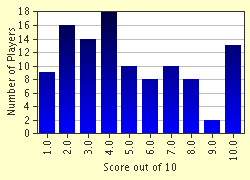Quiz Answer Key and Fun Facts
1. During his second voyage to the West Indies in 1494, Christopher Columbus landed on Jamaica's shores and became the first European to "discover" the island and its people, an Arawak tribe called Tainos. The Tainos, originally from Guyana, South America, knew the island by the name "Xamayca". What does the name translate as?
2. Although sacked by the British in 1596 and 1643, Jamaica remained a Spanish colony until 1655. On May 10, an English army commanded by Admiral Penn and General Venables landed in Kingston Harbour on the south coast of Jamaica and marched on the island capital of St. Jago de la Vega. Sent by Oliver Cromwell, the British detachment had earlier attempted to conquer another island but were instead defeated. Which island was the original target?
3. Between 1660-1700, piracy on the high seas enjoyed a renaissance around the Caribbean. Because of ongoing conflicts among England, France, Spain, and the Netherlands, it was tolerated and even encouraged, especially if waged against the enemy. In addition to being a temporary Governor of Jamaica three times (1673, 1677, 1680), this man was also known as Jamaica's most famous and daring pirate. Who was he?
4. Port Royal is a small isthmus jutting out from the mainland on Jamaica's south coast. During the 1600s, riches, pirate treasure, hedonism, and power all centred in that one tiny town. On June 7, 1692, a monumental event occurred in Jamaica that changed the course of the island's history. What happened?
5. The English became the new colonists in Jamaica and went about establishing prosperous sugar plantations. A continuing annoyance to their uninterrupted prosperity was the existence of a guerrilla group known as the Maroons. Beginning in 1663, they tried to suppress the band of ex-slaves but without much success. Around 1700, there emerged amongst the Maroons a woman who became well known for her military strategy and unifying strength against the British. Who was she?
6. In 1760, there was a violent revolt by over a thousand slaves in the northern Parish of St. Mary. Seizing the town of Port Maria, they captured and killed as many colonists as they could. Who led this violent revolt?
7. In 1793, the Maroons of the Parish of Trelawny, a parish named after 1767 Governor Sir William Trelawny, revolted due to continued mistreatment by the current Government. After months of fruitless struggle, the Maroons surrendered with the promise of being allowed to remain on the island. Instead, they were shipped off to Africa. Where did the displaced Maroons end up?
8. On March 1, 1808 the importation of slaves from Africa was officially discontinued in the first significant step towards Emancipation on August 1, 1838. Before 1838, significant slave uprisings occurred in 1746, 1760, 1798, 1809, and 1831. The December (28) uprising of 1831, called the Christmas Rebellion, was believed to have killed all hopes of the colonists wanting to continue with slavery. Who led this rebellion?
9. The Parish of St. Thomas lies in the eastern part of Jamaica. In 1865, the small capital city of Morant Bay was the scene of an outbreak of violence that culminated in the hangings of men who became National Heroes. Who were they?
10. Jamaica finally achieved Independence on August 6, 1962. The country then went about adopting "official emblems" such as a national bird, fruit, flower, tree, and motto. What "official" motto did the country adopt?
Source: Author
benniebenbenny
This quiz was reviewed by FunTrivia editor
bloomsby before going online.
Any errors found in FunTrivia content are routinely corrected through our feedback system.

